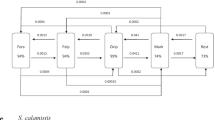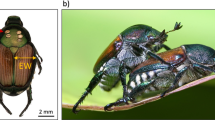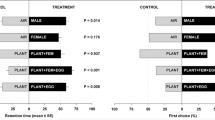Abstract
Before oviposition, Östrinianubilalis Hübner females sweep the surface of the plant with their abdominal tip extruded. The consequences of such behaviour were studied on host searching and oviposition behaviours of the parasitoidTrichogramma brassicae Bezdenko. Egg-masses ofO. nubilalis, associated or not with sweeping, were submitted toT. brassicae females. The behaviour ofT. brassicae females appeared to be very different between the two situations. The parasitoid in the vicinity of an egg-mass associated with sweeping spent more time on the corn leaf. Ninety percent of females located the egg-mass with sweeping, whereas only 40% located the egg-mass without sweeping. Eighty three percent ofT. brassicae females parasitized egg-masses with sweeping, but only 10% in the case without sweeping. Although no deposit was visible, a chemical trail was probably left behind and was found to arrest the parasitoid, to promote host recognition and to trigger oviposition. The amount of the scales left behind on the corn leaf during the sweeping behaviour was also taken into account but did not appear to constitute the trail. The passage over the trail followed by the egg-mass examination constituted behavioural steps which seemed necessary for oviposition in theT. brassicae female
Résumé
Avant de pondre, les femelles d’Ostrinia nubilalis balayent la surface du végétal avec leur extrémité abdominale dévaginée. Les conséquences d’un tel comportement sont étudiées sur les comportements de recherche et d’oviposition du parasitoïdeTrichogramma brassicae Bezdenko. Les femelles deT. brassicae sont mises en présence d’une ooplaque associée ou non à un balayage. Le comportement des femelles deT. brassicae est très différent entre les deux situations. Le temps de présence du parasitoïde sur la feuille de maïs, à proximité de l’ooplaque associée à un balayage, est plus important. Puis, 90 % des femelles trouvent l’ooplaque contre 40 % sans balayage. Enfin, 83 % parasitent l’oeuf hôte contre 10 % sans balayage. Bien qu’aucun dépôt ne soit visible, une trace de nature chimique est probablement déposée. Le parasitoïde se fixe sur cette trace. Elle favorise la reconnaissance de l’hôte et le déclenchement de la ponte. Le rôle des écailles, perdues sur le maïs lors du balayage, a également été pris en compte. Elles n’apparaissent pas constituer la trace. Le passage sur la trace suivi de la prospection de l’oeuf est une succession d’actes qui semblent nécessaires aux femelles deT. brassicae pour aboutir à l’oviposition
Similar content being viewed by others
References
Beevers, M., Lewis, W. J., Gross, H. R. &Nordlund, D. A. - 1981. Kairomones and their use for management of entomophagous insects. X. Laboratory studies on manipulation of host finding behavior ofTrichogramma pretiosum Riley with a kairomone extracted fromHeliothis zea (Boddie) moth scales. -J. Chem. Ecol., 7, 635–648.
Frenoy, C., Farine, J. P., Hawlitzky, N. &Durier, C. - 1991. Role of kairomones in the relations betweenOstrinia nubilalis Hübner (Lep., Pyralidae) andTrichogramma brassicae Bezdenko (Hym., Trichogrammatidaé). -Insect parasitoids, 4th European Workshop Perugia 3–5 april 1991, 74, 143–151.
Frenoy, C., Durier, C. &Hawlitzky, N. - 1992. Effect of kairomones from egg and female adult stages ofOstrinia nubilalis Hübner (Lepidoptera, Pyralidae) onTrichogramma brassicae Bezdenko (Hymenoptera, Trichogrammatidaé) female kinesis. -J. Chem. Ecol., 18, 761–773.
Gardner, S. M. & Van Lenteren, J. C. - 1986. Characterisation of the arrestment responses ofTrichogramma evanescens. -Oecologia, 265–270.
Gueldner, R. C., Nordlund, D. A., Lewis, W. J., Thean, J. E. &Wilson, D.M.-1984. Kairomones and their use for management of entomophagous insects. XV. Identification of several acids in scales ofHeliothis zea moth and comments on their possible role as kairomones forTrichogramma pretiosum. -J. Chem. Ecol.,10, 245–251.
Hattori, M. - 1988. Host-plant factors responsible for oviposition behaviour in the limabean pod borer,Etiella zinckenella Treitschke. -J. Insect Physiol., 3, 191–196.
Jones, R. L., Lewis, W. J., Beroza, M., Bierl, B. &Sparks, A. N. - 1973. Host-Seeking Stimulants (kairomones) for the Egg Parasite,Trichogramma evanescens. -Environ. Entomol., 2, 593–596.
Kaiser, L., Pham-Delegue, M. H., Bakchine, E. &Masson, C. - 1989. Olfactory responses ofTrichogramma ma’idis Pint, et Voeg.: effects of chemical cues and behavioral plasticity. -J. Insect Behav.,2, 701–712.
Laing, J. - 1937. Host-finding by insect parasites. I. Observations on the finding of hosts byAlysia manducator, Mormoniella vitripennis andTrichogramma evanescens. -J. Anim. Ecol., 6, 298–317.
Lewis, W. J., Sparks, A. N. &Redlinger, L. M. - 1971. Moth odor: a method of host-finding byTrichogramma evanescens. -J. Econ. Entomol.,64, 557–558.
Lewis, W. J., Jones, R. L. &Sparks, A. N. - 1972. A Host-seeking stimulant for the egg parasiteTrichogramma evanescens: its source and demonstration of its laboratory and field activity. -Ann. Entomol. Soc. Am., 65, 1087–1089.
Lewis, W. J., Beevers, M., Nordlund, D. A., Gross, H. R. &Hagen, K. S. -1979. Kairomones and their use for management of entomophagous insects. IX. Investigations of various kairomonetreatment patterns forTrichogramma spp. -J. Chem. Ecol., 5, 673–680.
Lewis, W. J., Nordlund, D. A, Gueldner, R. C., Teal, P. E. A. &lumlinson, J. H. - 1982. Kairomones and their use for management of entomophagous insects. XIII. Kairomonal activity forTrichogramma spp. of abdominal tips, excretion and a synthetic sex pheromone blend ofHeliothis zea (Boddie) moths. -J. Chem. Ecol., 8, 1323–1331.
Ma, P. W. K. &.Roelofs, W. L. - 1995. Sites of synthesis and release of PBAN-like factor in the female European corn borer,Ostrinia nubilalis. -J. Insect. Physiol.,41, 339–350.
Marion-Poll., F. C., Guillaumin, D. &Masson, C. - 1992. Sexual dimorphism of tarsal receptors and sensory equipment of the ovipositor in the European corn borer,Ostrinia nubilalis. -Cell. Tissue Res., 267, 507–518.
Morrison, G. &Lewis, W. J. - 1981. The allocation of searching time byTrichogramma pretiosum in host-containing patches. -Entomol. Exp. Appl., 30, 31–39.
Noldus, L. P. J. J. & Van Lenteren, J. C. - 1983. Kairomonal effects on searching for eggs ofPieris brassicae of the parasiteTrichogramma evanescens Westwood. -Med. Fac. Landbouww. Rijksuniv., 48, 183–194.
Noldus, L. P. J. J. & Van Lenteren, J. C. - 1985a. Kairomones for the egg parasiteTrichogramma evanescens Westwood. I. Effect of volatile substances released by two of its hosts,Pieris brassicae L. andMamestra brassicae L. -J. Chem. Ecol., 11, 781–791.
Noldus, L. P. J. J. & Van Lenteren, J. C. - 1985b. Kairomones for theQgg parasiteTrichogramma evanescens Westwood. II. Effect of contact chemicals produced by two of its hosts,Pieris brassicae L. andMamestra brassicae L. -J. Chem. Ecol., 11, 793–800.
Nordlund, D. A., Lewis, W. J., Todd, J. W. &Chalfant, R. B. - 1977. Kairomones and their use for management of entomophagous insects. VII. The involvement of various stimuli in the differential response ofTrichogramma pretiosum Riley to two suitable hosts. -J. Chem. Ecol., 3, 513–518.
Pak, G. A. - 1988. Selection ofTrichogramma for inundative biological control. -PhD thesis,Wageningen Agricultural University, The Netherlands, 224 pp.
Pompanon, F., Fouillet, P., Allemand, R. &Bouletreau, M. - 1993. Organisation temporelle de l’activité locomotrice chez les trichogrammes (Hym., Trichogrammatidae): variabilité et relation avec Tefficacité du parasitisme. -Bull. Soc. Zool. France, 118, 141–148.
Prokopy, R. J. - 1972. Evidence for a marking pheromone deterring repeated oviposition in apple maggot flies. -Environ. Entomol., 1, 326–332.
Prokopy, R. J., Webster, R. P. - 1978. Oviposition-deterring pheromone ofRhagoletis pomonella. A kairomone for its parasitoidOpius lectus. -J. Chem. Ecol., 4, 481–494.
Ramaswamy, S. - 1990. Periodicity of oviposition, feeding, and calling by mated femaleHeliothis virescens in a field cage. -J. Insect Behav., 3, 417–427.
Renou, M., Hawlitzky, N., Berthier, A., Malosse, C. &Ramiandrasoa, F. -1989. Mise en évidence d’une activité kairomonale des æufs de la pyrale du maïs sur les femelles deTrichogramma maïdis. -Entomophaga., 34, 569–580.
Renou, M., Nagnan, P., Berthier, A. & Durier, C. - 1992. Identification of compounds from the eggs ofOstrinia nubilalis andMamestra brassicae having kairomone activity onTrichogramma brassicae. -Entomol. Exp. Appl., 291–303.
Shu, S. &Jones, R. L.-1989. Kinetic Effects of a kairomone in Moth Scales of the European Corn Borer onTrichogramma nubilalae Ertle and Davis (Hymenoptera Trichogrammatidae). -J. Insect Behav., 2, 123–131.
Shu, S., Swedenborg, P. D. &Jones, R. L. - 1990. A kairomone forTrichogramma nubilale (Hymenoptera: Trichogrammatidae) isolation, identification, and synthesis. -J. Chem. Ecol., 16, 521–529.
Smits, P. H.- 1982. The influence of kairomones ofMamestra brassicae L. (Noctuidae) on the searching behaviour ofTrichogramma evanescens Westwood. -Les Trichogrammes, Ier Symposium international Antibes, 20–23 avril 1982. Les Colloques de l’INRA., 139–150.
Zaborski, E., Teal, P. E. A. & Laing, J. E. - 1987. Kairomone-mediated host finding by spruce budworm egg parasite,Trichogramma minutum. -J. Chem. Ecol., 113–122.
Author information
Authors and Affiliations
Rights and permissions
About this article
Cite this article
Garnier-Geoffroy, F., Robert, P., Hawlitzky, N. et al. Oviposition behaviour inOstrinia nubilaus (Lep.: pyralidae) and consequences on host location and oviposition inTrichogramma brassicae (Hym.: Trichogrammatidae). Entomophaga 41, 287–299 (1996). https://doi.org/10.1007/BF02764254
Received:
Accepted:
Published:
Issue Date:
DOI: https://doi.org/10.1007/BF02764254




